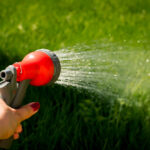

A lush, green lawn is a point of pride for many homeowners in Texas. However, the unforgiving summer months can leave your lawn looking patchy, brown, and brittle. Between scorching temperatures, limited rainfall, and the occasional drought, maintaining a vibrant lawn can feel like an uphill battle. But with the right approach, you can bring your lawn back to life and ensure it thrives for the seasons to come.
Assessing the Damage
The first step in revitalizing your lawn is understanding the extent of the damage caused by the harsh summer. Common signs of stress include dry, yellow patches, thinning grass, and compacted soil. Take a closer look to determine whether the damage is merely cosmetic or if the underlying structure of the lawn has been compromised.
If the grass crowns—the base of the blades where new growth emerges—are still green, your lawn likely has a chance to recover with proper care. However, if the crowns are brown and brittle, you may need to reseed or replace sections of the lawn entirely.
Aeration: Giving Your Lawn Room to Breathe
One of the most effective ways to kickstart the recovery process is by aerating your lawn. Aeration involves perforating the soil with small holes to improve air circulation, water absorption, and nutrient delivery to the grassroots. The compacted soil that often results from high foot traffic and dry conditions can suffocate your lawn, preventing it from receiving the resources it needs.
In Texas, fall is an ideal time to aerate, as the cooler weather reduces stress on the grass. This process can be done manually with a hand aerator or more efficiently with a powered aerator. Once aeration is complete, your lawn will be better equipped to absorb water and nutrients, setting the stage for healthy growth.
Reseeding for a Fresh Start
After a Texas summer, many lawns develop bare or thinning patches that require reseeding. Selecting the right grass seed is crucial for success. Choose a variety suited to Texas’s climate, such as Bermuda grass, Zoysia grass, or Buffalo grass. These warm-season grasses are resilient to heat and drought, making them ideal for the region.
To reseed effectively, follow these steps:
- Prepare the Soil: Rake the bare patches to remove dead grass and debris, ensuring the soil is loose and ready to receive the seeds.
- Spread the Seeds: Distribute the seeds evenly across the affected areas. For best results, use a seed spreader to avoid clumping.
- Water Consistently: Keep the soil moist by watering lightly but frequently. Consistent hydration is vital for seed germination, especially in Texas’s unpredictable fall weather.
If you’re looking for high-quality reseeding products, consider exploring the range offered by local grass suppliers in Texas. Many of these products are specifically designed to withstand the region’s challenging climate and ensure optimal results.
Fertilization: Feeding Your Lawn Back to Health
Once your lawn has been aerated and reseeded, it’s time to focus on nutrition. Fertilization provides your grass with the essential nutrients it needs to recover from summer stress and prepare for winter dormancy.
Choose a slow-release fertilizer rich in nitrogen, phosphorus, and potassium. Nitrogen promotes healthy blade growth, phosphorus supports root development, and potassium enhances the lawn’s overall resilience. Apply the fertilizer evenly across the lawn, following the manufacturer’s recommendations for coverage and application rates.
In addition to commercial fertilizers, you can visit your local grass store in Texas that offers eco-friendly and organic options. These products not only nourish your lawn but also contribute to sustainable gardening practices.
Watering: Timing Is Everything
Proper watering is the cornerstone of lawn recovery. After the intense summer heat, your lawn needs consistent hydration to regain its strength. However, overwatering can lead to problems such as fungal growth and root rot.
The key is to water deeply and infrequently, encouraging the grassroots to grow deeper into the soil. Aim to water your lawn early in the morning to minimize evaporation and allow the grass to absorb moisture before the day’s heat sets in. A general guideline is to provide your lawn with about one inch of water per week, either through rainfall or irrigation.
Dealing with Weeds and Pests
Weeds and pests often take advantage of weakened lawns, making them a common problem after a harsh summer. Weeds compete with grass for nutrients and water, while pests such as grubs and chinch bugs can cause extensive damage to the roots.
Address these issues promptly by applying appropriate herbicides and pesticides. Pre-emergent herbicides can prevent weeds from taking root, while targeted insecticides can eliminate pests without harming beneficial insects. If you prefer a natural approach, consider organic solutions or companion planting to deter pests.
Partnering with Local Experts
Revitalizing your lawn after a tough summer can be a daunting task, but you don’t have to go it alone. Partnering with a trusted local grass supplier in Texas can provide you with access to high-quality products and expert advice tailored to your specific needs.
Whether you need premium grass seed for reseeding, restoration products, or guidance on maintaining your lawn, local suppliers are an invaluable resource. They understand the unique challenges posed by Texas’s climate and can recommend solutions that deliver lasting results.
Maintaining Your Lawn for Future Summers
Revitalizing your lawn is just the first step—ongoing maintenance is essential to keep it healthy and vibrant year after year. Here are a few tips to prepare your lawn for future Texas summers:
- Regular Mowing: Keep your grass at the recommended height for its variety to encourage strong root growth and shade the soil.
- Seasonal Fertilization: Fertilize your lawn at key points throughout the year to provide consistent nourishment.
- Soil Testing: Periodically test your soil’s pH and nutrient levels to address imbalances before they become problems.
- Consistent Watering: Establish a reliable watering routine that adapts to seasonal changes and weather conditions.
By taking these proactive steps, you can ensure your lawn remains a beautiful and functional part of your property, even under the challenges of Texas summers.
Conclusion
Revitalizing your lawn after a harsh Texas summer may require effort and patience, but the rewards are well worth it. By assessing the damage, aerating the soil, reseeding, fertilizing, and maintaining proper watering practices, you can restore your lawn to its former glory. With the help of high-quality restoration products from trusted Texas grass suppliers, your lawn will not only recover but thrive in the seasons to come.
Take the first step today by exploring the range of reseeding and restoration products available from local experts. With the right tools and techniques, your lawn can become the lush, green oasis you’ve always envisioned.
The post How to Revitalize Your Lawn After a Harsh Texas Summer appeared first on Our Culture.






